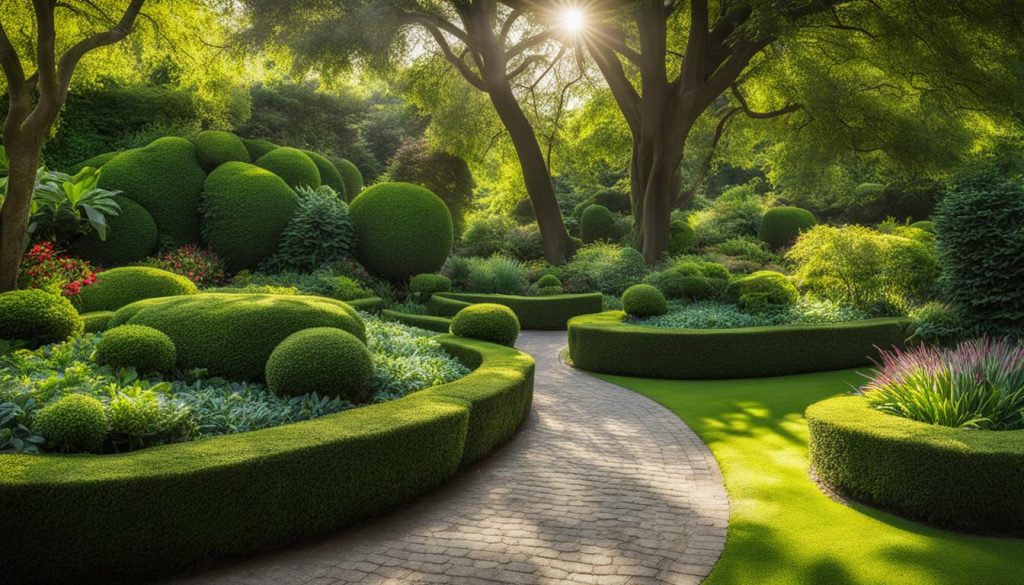Welcome to our latest article on energy-efficient landscaping, where we explore how you can create a green oasis that saves energy and enhances the appeal of your home.
As Canadians, we understand that energy consumption can be a major concern for many homeowners, especially during the hot summer months. However, by implementing various landscaping techniques, you can significantly reduce your energy usage and create a welcoming outdoor space for your family and friends.
Energy-efficient landscaping involves incorporating shade and greenery to reduce heat absorption and promote natural cooling. Not only does this help save energy, but it also creates a beautiful landscape that enhances the overall appeal of your home.
In this article, we will delve into the numerous benefits of energy-efficient landscaping and show you how to create shade through the strategic placement of trees and pergolas. We’ll also explore the power of greenery in reducing heat absorption and minimizing water usage. Plus, we’ll provide tips on water-wise landscaping and efficient irrigation systems, as well as the latest trends in landscape design.
So, whether you’re looking to save energy, reduce your utility bills, or simply enhance the beauty of your home’s exterior, energy-efficient landscaping is the answer. Let’s get started!
The Benefits of Energy-Efficient Landscaping
When it comes to landscaping, most homeowners focus on aesthetics without realizing that it can also be an effective way to reduce energy consumption and lower utility bills. That’s where energy-efficient landscaping comes into the picture. By creating a green oasis that saves energy, you can enhance the appeal of your home while enjoying numerous other benefits that come with it.
First and foremost, landscaping that is designed to be energy-efficient can significantly reduce energy consumption in your home. By strategically planting trees and other greenery, you can create shade that blocks the intense summer sun and reduces the need for air conditioning. Not only will this lower your energy bills, but it will also lighten the load on your air conditioning unit, reducing wear and tear and prolonging its lifespan.
In addition to reducing energy consumption, an energy-efficient landscape can also communicate your commitment to sustainability and environmental responsibility. By incorporating native plants, groundcover, and other features that reduce water usage and minimize heat absorption, you can conserve natural resources and reduce your carbon footprint.
Ultimately, creating an energy-efficient landscape is a smart investment for your home and the environment. Not only will it save you money on utility bills, but it will also enhance the curb appeal of your property and increase its overall value.
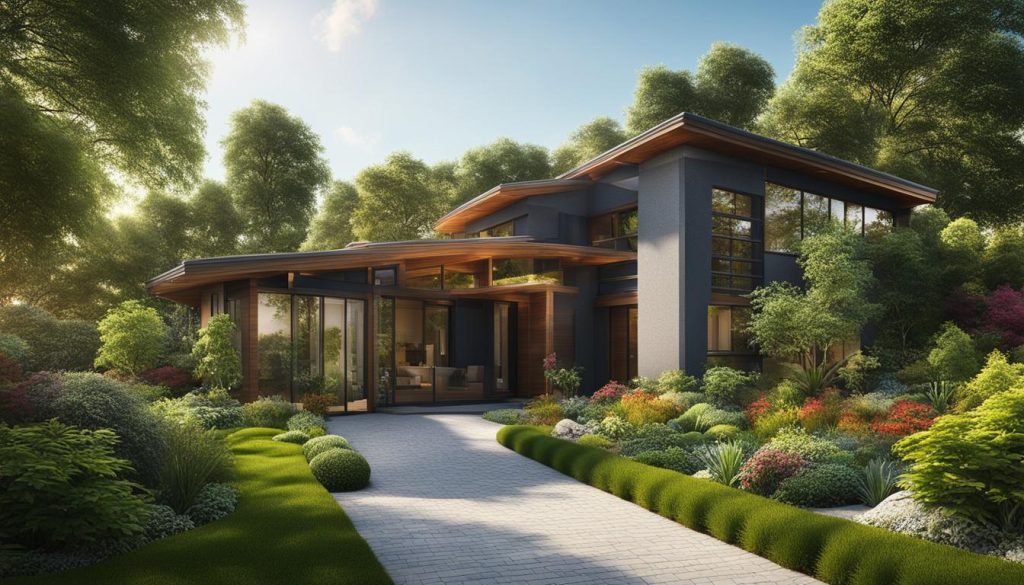
Creating Shade: A Cool Solution
When planning an energy-efficient landscape, creating shade is a key consideration. Shade not only helps keep your outdoor spaces cool and comfortable, but it can also reduce your overall energy consumption. There are several ways we can create shade in our landscapes.
Strategically placing trees for shade
Trees are a beautiful and effective way to create shade in your landscape. By planting deciduous trees on the south and west sides of your property, you can block the hot summer sun while allowing sunlight to warm your home during the winter months. For maximum shading, select trees with a wide canopy, such as maple, oak, or elm. Remember to place trees away from your home’s foundation to avoid potential damage from root growth.
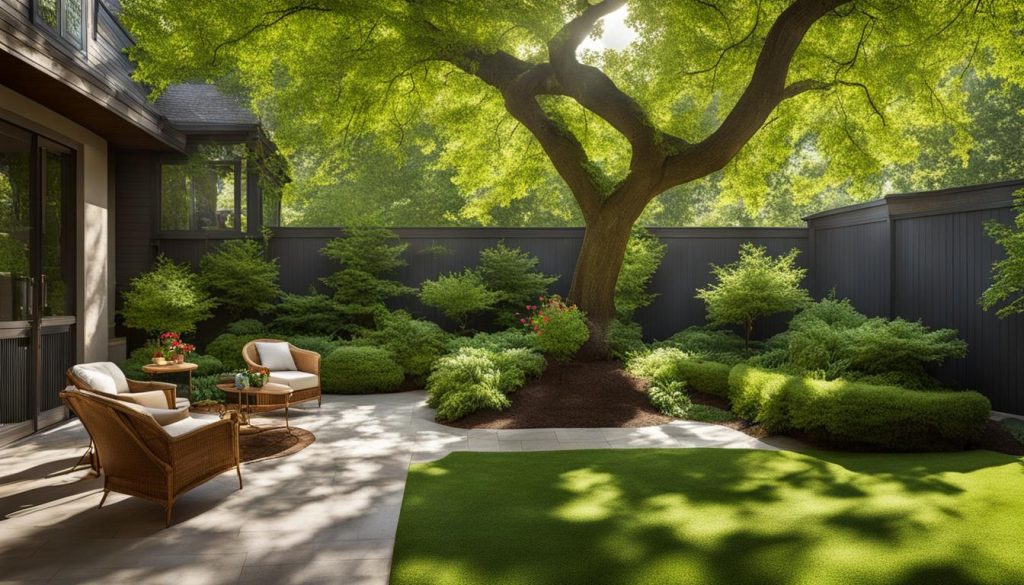
Incorporating pergolas and other shade structures
Pergolas and other shade structures are another effective way to create shade in your landscape. These structures not only provide relief from the sun, but they can also add an elegant touch to your outdoor space. When selecting a shade structure, consider the direction of sunlight and aim to position it to block the hottest rays of the day. Options include standalone structures or attached structures that can be built onto your home’s exterior.
Selecting the right trees for shading
When selecting trees for shading, consider the size of your property and the amount of shade you need. For smaller yards, a single tree can provide enough shade, but for larger properties, multiple trees may be needed. Be sure to research the specific trees you are considering and choose ones that are well-suited to your climate and soil conditions. By selecting the right trees for shading, you can enjoy a cooler and more energy-efficient outdoor space.
The Power of Greenery: Plants for Energy Efficiency
Greenery is a powerful tool in creating an energy-efficient landscape. By using the right plants, we can reduce heat absorption, minimize water usage, and create a beautiful and functional outdoor space.
One of the best ways to incorporate greenery into your landscape is by using native plants. These plants are adapted to the local climate and require less water and maintenance than non-native plants. They also provide food and habitat for local wildlife, further enhancing the biodiversity of your landscape.
In addition to native plants, groundcover can also be used to create a more energy-efficient landscape. Groundcover plants help to reduce heat absorption and soil erosion, while also suppressing weeds. Some examples of groundcover plants include creeping thyme, sedum, and clover.
Best Plants for Energy Efficiency
- Shrubs: Shrubs are an excellent way to add texture and structure to your landscape. They also provide shade and can help reduce energy consumption by blocking sunlight from windows and walls. Some native shrub options include dogwood, serviceberry, and elderberry.
- Trees: Strategically planting trees can help create shade and reduce energy consumption by blocking sunlight from your home. It’s important to select the right trees for shading based on their height, canopy spread, and distance from your house. Some options for shade trees include maple, oak, and birch.
- Vines: Vines are a great way to add vertical interest to your landscape while also providing shade and reducing heat absorption. Some native vine options include Virginia creeper, trumpet vine, and clematis.
By incorporating these energy-efficient plants into your landscape, you can create a green oasis that not only saves energy but also enhances the beauty and functionality of your outdoor space. Remember to also consider the use of groundcover and native plants to help create a more sustainable and low-maintenance landscape.
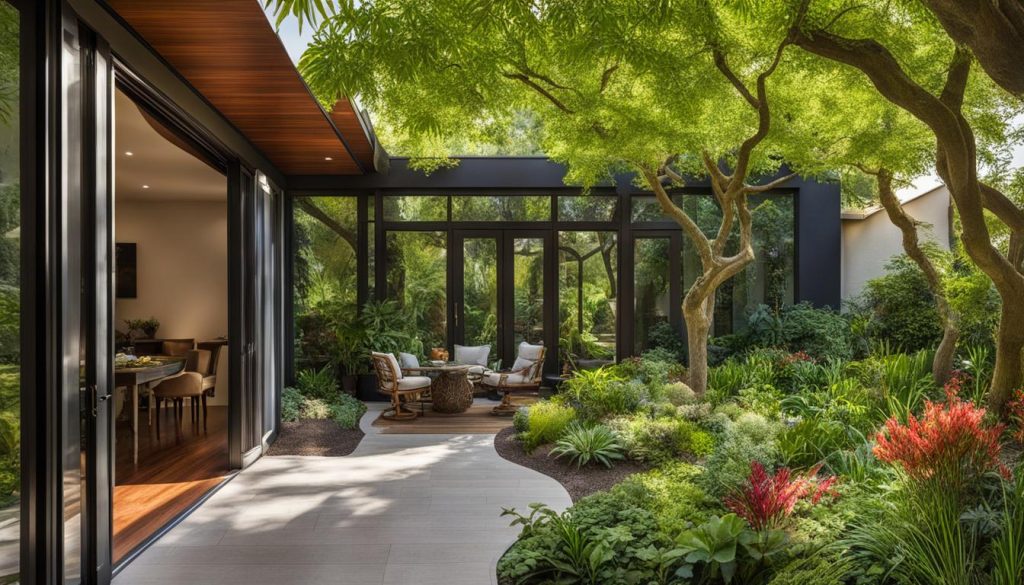
Water-Wise Landscaping: Efficient Irrigation Systems
When it comes to energy-efficient landscaping, water conservation is key. That’s why we recommend implementing water-wise strategies like efficient irrigation systems. By minimizing water waste, you can maintain a thriving landscape while also reducing your water bill.
Drip irrigation is one of the most effective methods for conserving water in landscaping. By providing slow, steady water directly to the roots of plants, drip irrigation avoids overwatering and reduces evaporation. Plus, it can be easily automated, so you don’t have to worry about manually watering your plants.
Another option is to use rainwater harvesting systems to collect rainwater for later use in irrigation. This not only conserves water but also reduces the demand on municipal water sources.
When selecting an irrigation system, consider factors like the size and layout of your landscape, the type of plants you have, and your local climate. Consulting with a professional landscaper can help you choose the most efficient and effective system for your specific needs.
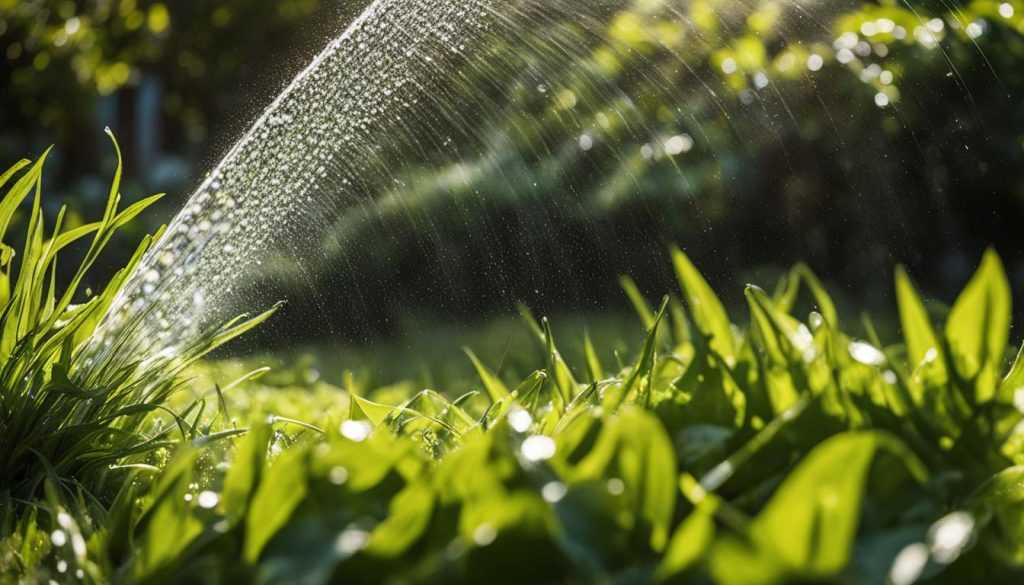
Maximizing Efficiency with Smart Technology
In addition to efficient irrigation systems, you can also optimize your water usage with smart technology. Smart irrigation controllers use weather data to adjust irrigation schedules based on current conditions, ensuring that your plants receive the right amount of water at the right time.
Some controllers can even be controlled remotely through a smartphone app, allowing you to monitor and adjust your irrigation system from anywhere. This not only saves water but also saves time and hassle by eliminating the need for manual adjustments.
By incorporating water-wise strategies like efficient irrigation systems and smart technology, you can create a beautiful and sustainable landscape that enhances the appeal of your home while also conserving water and lowering your water bill.
Enhancing Your Home’s Appeal with Landscape Design
Landscape design is not just about creating a beautiful outdoor space; it’s also about enhancing the curb appeal of your home. A well-designed landscape can add value to your property while improving its overall aesthetic appeal. At Landscape Designer, we specialize in providing professional landscaping services that can transform your property into a work of art.
Creating a Cohesive Design
One of the most important aspects of landscape design is creating a cohesive design that complements the architecture of your home. A well-designed landscape should flow seamlessly with the natural contours of your property and create a sense of unity with your home’s exterior. Our team of experts can help you achieve this by carefully selecting plants and materials that work together to create a harmonious design.
Adding Color and Texture
One way to enhance the curb appeal of your home is by adding color and texture to your landscape. We can help you select plants and flowers that bloom at different times of the year, ensuring that your property always looks its best. Additionally, we can incorporate different textures and materials, such as stone pathways and water features, to add visual interest to your outdoor space.
Improving Functionality
While aesthetics are important, so is functionality. Our team can help you design a landscape that not only looks great but also meets your practical needs. For example, we can create designated zones for outdoor entertaining or install outdoor lighting for added safety and security. We can also recommend the best types of plants and materials for your specific climate and soil conditions.
At Landscape Designer, we are committed to providing our clients with professional landscaping services that enhance the beauty and functionality of their outdoor spaces. Contact us today to learn more about our landscape design services and how we can help you achieve the perfect curb appeal for your home.
FAQ
What is energy-efficient landscaping?
Energy-efficient landscaping refers to the practice of designing and maintaining outdoor spaces in a way that reduces energy consumption and promotes environmental sustainability. It involves incorporating shade, greenery, and water-wise techniques to create a more comfortable and efficient outdoor environment.
What are the benefits of energy-efficient landscaping?
Energy-efficient landscaping offers numerous benefits. By reducing energy consumption, it can help lower your utility bills. It also creates a more comfortable outdoor space by providing shade and reducing heat absorption. Additionally, it promotes environmental sustainability by conserving water and minimizing the use of chemical pesticides and fertilizers.
How can I create shade in my landscape?
There are several ways to create shade in your landscape. One option is to strategically plant trees that provide shade for your outdoor areas. You can also incorporate shade structures like pergolas and awnings. These structures not only provide shade but also enhance the aesthetic appeal of your outdoor space.
What are the best plants for energy efficiency?
Native plants and groundcover are excellent choices for energy-efficient landscaping. They are well adapted to the local climate and require less water and maintenance compared to non-native plants. They also help reduce heat absorption, keeping your outdoor space cooler. Consider using plants that have low water requirements and are suitable for your region.
What is water-wise landscaping?
Water-wise landscaping, also known as xeriscaping, is an approach to landscaping that focuses on conserving water. It involves using plants that are drought-tolerant, implementing efficient irrigation systems like drip irrigation, and minimizing water waste. Water-wise landscaping allows you to maintain a beautiful outdoor space while minimizing your water usage.
How can landscape design enhance my home’s appeal?
Landscape design plays a crucial role in enhancing your home’s appeal. A well-designed landscape can significantly improve curb appeal, making your home more attractive to potential buyers and visitors. Professional landscaping services can help you create a cohesive and visually appealing outdoor space that complements your home’s architecture and style.

